
4/29/2025 10:07:02 AM
The Erechtheion of the Acropolis of Athens
The Erechtheion is a temple made of Pentelic marble with a unique architectural form. It is located on the northern side of the Acropolis rock and was constructed between 421 and 406 BC, to replace an earlier temple that stood further south and was dedicated to Athena Polias. The temple is referred to as "Erechtheion" by Pausanias (1.26.5), and this name is associated with the mythical king of Athens, Erechtheus, who was initially worshipped at this site. In other ancient sources, the building is usually referred to simply as "Temple" or "Ancient Temple." Its irregular shape is partly due to the configuration of the land and also to the two main cults it housed in two distinct areas. The eastern part of the temple was dedicated to Athena Polias, while the western part was dedicated to Poseidon-Erechtheus, and also contained altars to Hephaestus and Butes, the brother of Erechtheus. According to myth, the sacred serpent of Athena, the guardian snake, also resided here. Additionally, this area housed sacred sites that needed to be protected by the building, such as the tomb of Cecrops and traces commemorating the dispute between Athena and Poseidon over the guardianship of the city. An important feature of the temple is the Porch of the Caryatids. This is a small colonnade in the shape of the Greek letter "Π", where six statues of maidens replace the columns, supporting the roof with their heads. They were later called Caryatids because they were associated with the girls from the town of Caryae in Laconia, who danced in honor of the goddess Artemis.
Pictured: The Erechtheion of the Acropolis of Athens in 1878. ©Municipal Photography Museum of Kalamaria ‘Christos Kalemkeris’.

